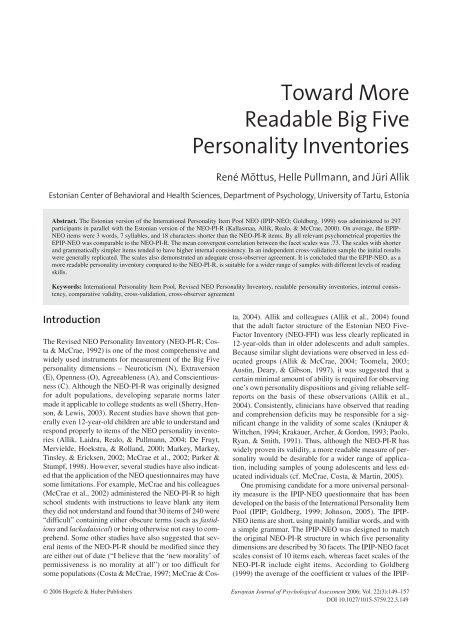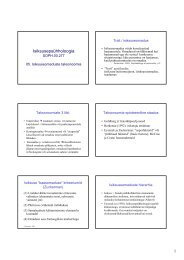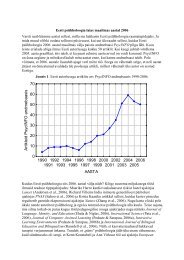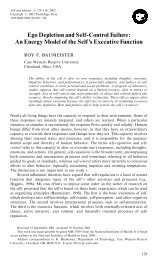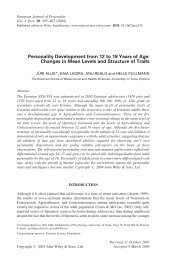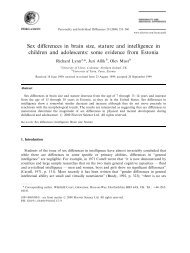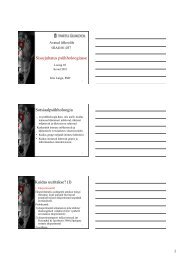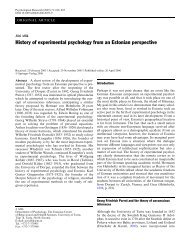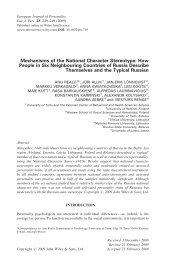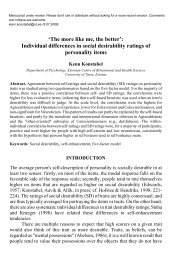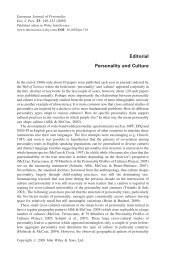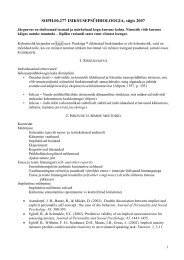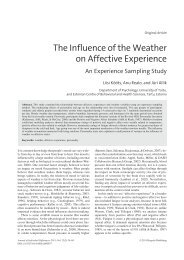Toward More Readable Big Five Personality Inventories
Toward More Readable Big Five Personality Inventories
Toward More Readable Big Five Personality Inventories
You also want an ePaper? Increase the reach of your titles
YUMPU automatically turns print PDFs into web optimized ePapers that Google loves.
European Journal R. Mõttus of Psychological et al.: The Assessment © IPIP-NE 2006 Hogrefe O 2006; <strong>Personality</strong> Vol. & Huber 22(3):149–157 Inventory Publishers<br />
<strong>Toward</strong> <strong>More</strong><br />
<strong>Readable</strong> <strong>Big</strong> <strong>Five</strong><br />
<strong>Personality</strong> <strong>Inventories</strong><br />
René Mõttus, Helle Pullmann, and Jüri Allik<br />
Estonian Center of Behavioral and Health Sciences, Department of Psychology, University of Tartu, Estonia<br />
Abstract. The Estonian version of the International <strong>Personality</strong> Item Pool NEO (IPIP-NEO; Goldberg, 1999) was administered to 297<br />
participants in parallel with the Estonian version of the NEO-PI-R (Kallasmaa, Allik, Realo, & McCrae, 2000). On average, the EPIP-<br />
NEO items were 3 words, 7 syllables, and 18 characters shorter than the NEO-PI-R items. By all relevant psychometrical properties the<br />
EPIP-NEO was comparable to the NEO-PI-R. The mean convergent correlation between the facet scales was .73. The scales with shorter<br />
and grammatically simpler items tended to have higher internal consistency. In an independent cross-validation sample the initial results<br />
were generally replicated. The scales also demonstrated an adequate cross-observer agreement. It is concluded that the EPIP-NEO, as a<br />
more readable personality inventory compared to the NEO-PI-R, is suitable for a wider range of samples with different levels of reading<br />
skills.<br />
Keywords: International <strong>Personality</strong> Item Pool, Revised NEO <strong>Personality</strong> Inventory, readable personality inventories, internal consistency,<br />
comparative validity, cross-validation, cross-observer agreement<br />
Introduction<br />
The Revised NEO <strong>Personality</strong> Inventory (NEO-PI-R; Costa<br />
& McCrae, 1992) is one of the most comprehensive and<br />
widely used instruments for measurement of the <strong>Big</strong> <strong>Five</strong><br />
personality dimensions – Neuroticism (N), Extraversion<br />
(E), Openness (O), Agreeableness (A), and Conscientiousness<br />
(C). Although the NEO-PI-R was originally designed<br />
for adult populations, developing separate norms later<br />
made it applicable to college students as well (Sherry, Henson,<br />
& Lewis, 2003). Recent studies have shown that generally<br />
even 12-year-old children are able to understand and<br />
respond properly to items of the NEO personality inventories<br />
(Allik, Laidra, Realo, & Pullmann, 2004; De Fruyt,<br />
Mervielde, Hoekstra, & Rolland, 2000; Markey, Markey,<br />
Tinsley, & Ericksen, 2002; McCrae et al., 2002; Parker &<br />
Stumpf, 1998). However, several studies have also indicated<br />
that the application of the NEO questionnaires may have<br />
some limitations. For example, McCrae and his colleagues<br />
(McCrae et al., 2002) administered the NEO-PI-R to high<br />
school students with instructions to leave blank any item<br />
they did not understand and found that 30 items of 240 were<br />
“difficult” containing either obscure terms (such as fastidious<br />
and lackadaisical) or being otherwise not easy to comprehend.<br />
Some other studies have also suggested that several<br />
items of the NEO-PI-R should be modified since they<br />
are either out of date (“I believe that the ‘new morality’ of<br />
permissiveness is no morality at all”) or too difficult for<br />
some populations (Costa & McCrae, 1997; McCrae & Costa,<br />
2004). Allik and colleagues (Allik et al., 2004) found<br />
that the adult factor structure of the Estonian NEO <strong>Five</strong>-<br />
Factor Inventory (NEO-FFI) was less clearly replicated in<br />
12-year-olds than in older adolescents and adult samples.<br />
Because similar slight deviations were observed in less educated<br />
groups (Allik & McCrae, 2004; Toomela, 2003;<br />
Austin, Deary, & Gibson, 1997), it was suggested that a<br />
certain minimal amount of ability is required for observing<br />
one’s own personality dispositions and giving reliable selfreports<br />
on the basis of these observations (Allik et al.,<br />
2004). Consistently, clinicians have observed that reading<br />
and comprehension deficits may be responsible for a significant<br />
change in the validity of some scales (Knäuper &<br />
Wittchen, 1994; Krakauer, Archer, & Gordon, 1993; Paolo,<br />
Ryan, & Smith, 1991). Thus, although the NEO-PI-R has<br />
widely proven its validity, a more readable measure of personality<br />
would be desirable for a wider range of application,<br />
including samples of young adolescents and less educated<br />
individuals (cf. McCrae, Costa, & Martin, 2005).<br />
One promising candidate for a more universal personality<br />
measure is the IPIP-NEO questionnaire that has been<br />
developed on the basis of the International <strong>Personality</strong> Item<br />
Pool (IPIP; Goldberg, 1999; Johnson, 2005). The IPIP-<br />
NEO items are short, using mainly familiar words, and with<br />
a simple grammar. The IPIP-NEO was designed to match<br />
the original NEO-PI-R structure in which five personality<br />
dimensions are described by 30 facets. The IPIP-NEO facet<br />
scales consist of 10 items each, whereas facet scales of the<br />
NEO-PI-R include eight items. According to Goldberg<br />
(1999) the average of the coefficient α values of the IPIP-<br />
© 2006 Hogrefe & Huber Publishers European Journal of Psychological Assessment 2006; Vol. 22(3):149–157<br />
DOI 10.1027/1015-5759.22.3.149
150 R. Mõttus et al.: The IPIP-NEO <strong>Personality</strong> Inventory<br />
NEO scales was a little higher than that of the NEO-PI-R<br />
(.80 and .75, respectively), which is almost exactly what<br />
could be predicted from the Spearman-Brown prophecy<br />
formula. The average cross-instrument agreement between<br />
corresponding scales of the NEO-PI-R and the IPIP-NEO<br />
was .73 (Goldberg, 1999). Thus, the psychometric quality<br />
of the IPIP-NEO scales looks promising. Nevertheless,<br />
more studies, including translations into different languages,<br />
are needed for generalizability of this preliminary observation.<br />
It is possible, however, that shorter, less sophisticated,<br />
and linguistically minimalist personality items are not able<br />
to convey the original meaning. For example, it has been<br />
claimed that the Openness to experience dimension is not<br />
well represented in natural language (McCrae, 1990) and<br />
it may also be problematic to represent it with unsophisticated<br />
statements. It is without doubt that simpler and less<br />
specific statements can become more ambiguous and can<br />
bring in undesirable shades of meaning. In addition, it is<br />
possible that easier items are more vulnerable to socially<br />
desirable responding, which can also compromise validity<br />
(cf. Stricker, 1963).<br />
The main goal of this study was to evaluate psychometric<br />
properties of the Estonian version of the IPIP-NEO, the<br />
Estonian <strong>Personality</strong> Item Pool NEO (EPIP-NEO), which<br />
was administered in parallel with the Estonian version of<br />
the NEO-PI-R (Kallasmaa et al., 2000). The aim was to<br />
establish to what extent the new and linguistically simpler<br />
personality inventory retained the intended five-factor<br />
structure, and showed acceptable internal consistency and<br />
external validity compared to the original NEO-PI-R.<br />
However, it was possible that the EPIP-NEO had an advantage<br />
over the NEO-PI-R because items of the former had<br />
been selected on the basis of the same data that was used<br />
for the comparisons. For this reason, a cross-validation<br />
sample was used to evaluate the properties of the EPIP-<br />
NEO in independent data. In addition, cross-validation data<br />
also allowed examination of the cross-observer agreement<br />
of the scales.<br />
Method<br />
Participants<br />
The initial sample consisted of 297 participants (94 men<br />
and 203 women) with a mean age of 31.34 years (SD =<br />
13.73, ranging from 16 to 86; for one participant the age<br />
was unknown). About 20% of the participants had completed<br />
a primary or basic education, 44% had finished a secondary<br />
or vocational school, 35% had a university degree;<br />
about 1% declined to declare their educational level. Thus,<br />
in respect to the educational level the sample was relatively<br />
heterogeneous. The subjects were instructed to fill out the<br />
questionnaires on two subsequent days. In order to avoid<br />
practice effects roughly half of the subjects filled out the<br />
European Journal of Psychological Assessment 2006; Vol. 22(3):149–157<br />
EPIP-NEO on the first day and other half on the second<br />
day.<br />
The cross-validation sample consisted of 182 participants<br />
(117 women and 54 men, 11 participants did not report<br />
their gender) with a mean age of 42.41 years (SD =<br />
17.78; ranging from 16 to 83; for nine participants the age<br />
was unknown). These participants also had various educational<br />
backgrounds, as approximately 18% of participants<br />
had a basic or primary education, 54% had completed a<br />
vocational or secondary school, and 23% had a university<br />
degree; about 5% did not report their educational level. In<br />
the cross-validation sample, 168 participants’ (targets) personality<br />
traits were also rated by two well-acquainted informants<br />
(judges), who were mostly close relatives, spouses,<br />
friends, or colleagues. Most of the judges also reported<br />
how long they had been acquainted with their target (n =<br />
324) and how well they knew him or her (n = 314). On<br />
average, the judges knew the target for 17.86 years (SD =<br />
12.59), more than 90% knew the target for at least 3 years<br />
and less than 2% knew the target for less than a year. About<br />
90% of the judges reported that they knew their target at<br />
least “satisfactorily well.”<br />
Measures<br />
EPIP-NEO<br />
The first author of this article translated the original IPIP-<br />
NEO items retaining their short and simple style. <strong>Five</strong> experts,<br />
including the coauthors, revised the translated items<br />
in order to make them as unsophisticated and readable as<br />
possible. In case of necessity grammar was simplified. All<br />
words considered uncommon by the experts and foreign<br />
words were replaced with more common nonforeign terms.<br />
Since balanced scales are suggested in order to diminish<br />
the confounding effects of acquiescent responding (Mc-<br />
Crae, Herbst, & Costa, 2001), a few additional items were<br />
generated for facet scales with unequal number of inverted<br />
and noninverted items. The final item pool of 397 items<br />
was back-translated by an English teacher who was unfamiliar<br />
with the inventory. The back-translated items were<br />
reviewed by John A. Johnson and according to his suggestions<br />
some revisions were made. In order to make the EPIP-<br />
NEO similar to the NEO-PI-R, eight items were selected<br />
for each facet scale. The selection was based on convergent<br />
and discriminant relations between items: Selected items<br />
correlated most with the other items of the intended scale<br />
and least with other scales. All facet scales except two (O6:<br />
Liberalism and A4: Cooperation) were balanced containing<br />
an equal number of positively and negatively keyed<br />
items. The selection of items was carried out only on the<br />
basis of the initial sample. In the cross-validation sample<br />
scale scores were comprised of the previously selected<br />
items. Judges used the same questionnaire, except that the<br />
items were worded in the third person form (i.e., “I am . . .”<br />
was replaced with “She/he is . . .”).<br />
© 2006 Hogrefe & Huber Publishers
R. Mõttus et al.: The IPIP-NEO <strong>Personality</strong> Inventory 151<br />
NEO-PI-R<br />
The main psychometric properties of the Estonian version<br />
of the NEO-PI-R are fully described elsewhere (Kallasmaa<br />
et al., 2000).<br />
Validity Criteria<br />
In order to validate both self-report personality questionnaires,<br />
a subset of participants of the initial sample (n =<br />
239, 75 men and 164 women; mean age 33.6 years, SD =<br />
13.73) used a 10-point scale (1 – never ... 10 – several<br />
times a day) to rate the frequency of several concrete behavioral<br />
acts that were considered typical indicators of either<br />
neuroticism or extraversion. First, the respondents<br />
were asked to indicate how frequently they had taken medication<br />
for depression. Based on their ratings, the subjects<br />
were assigned to two groups: those who had taken antidepressants<br />
during the last year (28%) and those who did not<br />
report taking the medication (72%). Second, an indicator<br />
of social activity was compiled from three items (“I am at<br />
a party or crowded event,” “I meet my friends,” and “I ask<br />
my friends whether they have plans for a party”). The scale<br />
had an internal consistency of .78.<br />
Results and Discussion<br />
Linguistic and psychometric properties of the EPIP-NEO<br />
and the NEO-PI-R scales are presented in Table 1. The<br />
EPIP-NEO items were on average 3 words, 7 syllables, and<br />
18 characters shorter than the NEO-PI-R items. In Estonian,<br />
the number of commas can also be used as a fairly<br />
good indicator of grammatical complexity. The EPIP-NEO<br />
had on average 0.10 whereas the NEO-PI-R included 0.48<br />
commas per item.<br />
On average, the Cronbach’s αs (see Table 1) of the EPIP-<br />
NEO facet scales were slightly higher than those of the<br />
NEO-PI-R facet scales (mean values were .79 and .76, respectively).<br />
Interestingly, internal consistencies of scales<br />
were related to the linguistic properties of items: The scales<br />
with shorter items tended to be internally more consistent.<br />
The correlations between scales’ average number of letters<br />
per items and the Cronbach’s αs were r = –.56 (p = .001)<br />
and r=–.33 (p = .08), respectively for the EPIP-NEO and<br />
the NEO-PI-R, and r = –.42 (p =.001) across all 60 facet<br />
scales. Although the magnitude of the relationship was affected<br />
by scales with more extreme item length and internal<br />
consistency, the tendency of scales with longer items to be<br />
internally less consistent was still noticeable. For example,<br />
ignoring the scales of the Openness dimension, which generally<br />
consisted of longer items, did not eradicate the relationship.<br />
Other supposedly relevant indicators of linguistic<br />
complexity (e.g., scales’ average number of syllables, commas<br />
and words per item) were similarly related to internal<br />
consistency.<br />
In the cross-validation sample the Cronbach’s αs were<br />
.95, .93, .89, .88, and .92 respectively for the N, E, O, A,<br />
and C domains. The α coefficients of the facet scales varied<br />
from .56 to .90 with an average value of .78. The mean α<br />
coefficient of the 30 NEO-PI-R facet scales reported by<br />
Kallasmaa and colleagues in an independent study (Kallasmaa<br />
et al., 2000) was .75. Thus, it is likely that in respect<br />
to internal consistency the EPIP-NEO is at least as good as<br />
the original NEO-PI-R. The previously reported relationship<br />
between scales’ internal consistency and linguistic<br />
properties also appeared in independent data. For example,<br />
the correlation between scales’ average number of letters<br />
per item and the Cronbach’s αs was r = –.54 (p < .01).<br />
Comparable patterns of correlations also appeared for the<br />
other linguistic properties.<br />
The mean values and standard deviations of the EPIP-<br />
NEO and the NEO-PI-R facet scales were rather similar.<br />
The mean profiles of the EPIP-NEO and the NEO-PI-R 30<br />
facet scales were highly correlated, r = .86 (p < .001). The<br />
convergent correlations between the corresponding facet<br />
scales (last column in Table 1) ranged from r = .45 to .84<br />
with an average correlation of r = .73.<br />
Principal component analysis (PCA) followed by Varimax<br />
rotation applied to the 30 facet scales of the EPIP-<br />
NEO revealed a typical five-factor structure (see Table 2).<br />
The first seven eigenvalues were 6.53, 5.06, 2.98, 2.49,<br />
1.67, .99, and .93. Parallel analysis (Zwick & Velicer, 1986)<br />
and other criteria (e.g., scree test) suggested retaining five<br />
factors that accounted for 62.4% of the total variance (in<br />
case of the NEO-PI-R the respective figure was 61.9%).<br />
The factor congruence coefficients between Varimax-rotated<br />
factor structures of the EPIP-NEO and the NEO-PI-R<br />
were .98, .97, .95, .95, and .97 for the N, E, O, A, and C<br />
factors, respectively. Generally, the typical five-factor<br />
structure of the NEO-PI-R was replicated by both inventories.<br />
After Procrustes rotation (McCrae, Zonderman, Costa,<br />
Bond, & Paunonen, 1996) targeted at the North-American<br />
normative structure of the NEO-PI-R (Costa & McCrae,<br />
1992), the factor congruence coefficients between North-<br />
American factors and respective factors obtained from the<br />
current data ranged from .95 to .96 and from .95 to .98 for<br />
the EPIP-NEO and the NEO-PI-R, respectively. However,<br />
some unintended primary loadings were observed for both<br />
measures. First, the N5 (Impulsiveness) of the EPIP-NEO<br />
had its primary loading on the C factor and a similar tendency<br />
appeared in the structure of the NEO-PI-R as the N5<br />
had equal loadings on the intended N factor and C factor.<br />
Incidentally, the “wrong” loading of the N5 on the C factor<br />
was not specific to this sample as the same has been seen<br />
previously (Kallasmaa et al., 2000). Analogously for both<br />
inventories, A5 (Modesty) had its primary loading on the<br />
E factor. Again, a similar deviation has been reported previously<br />
(Kallasmaa et al., 2000). <strong>More</strong> specific to the EPIP-<br />
NEO was the unintended primary loading of the O4 (Adventurousness)<br />
on the E factor. The facet scale A2<br />
© 2006 Hogrefe & Huber Publishers European Journal of Psychological Assessment 2006; Vol. 22(3):149–157
152 R. Mõttus et al.: The IPIP-NEO <strong>Personality</strong> Inventory<br />
Table 1. Linguistic and psychometric properties of the EPIP-NEO and the NEO-PI-R scales.<br />
Words Syllables<br />
EPIP-NEO<br />
Letters Commas<br />
α Mean SD Words Syllables<br />
NEO-PI-R<br />
Letters Commas<br />
α Mean SD r<br />
Neuroticism 4.94 10.21 24.73 0.06 .95 75.82 28.08 7.54 16.63 40.46 0.38 .94 85.84 26.09 .89<br />
Extraversion 4.69 10.27 25.10 0.02 .93 111.05 25.38 7.56 17.67 42.79 0.27 .94 110.82 27.05 .90<br />
Openness 5.98 13.56 32.79 0.13 .89 128.16 19.93 9.77 22.94 56.69 0.67 .89 117.31 21.50 .86<br />
Agreeableness 5.65 12.06 28.96 0.23 .90 126.26 20.59 8.33 18.67 45.69 0.61 .87 118.01 18.28 .83<br />
Conscientiousness 5.54 11.29 27.42 0.08 .93 120.89 23.79 8.21 18.40 44.46 0.48 .91 112.36 22.14 .87<br />
N1 Anxiety 4.75 10.00 24.00 0.00 .86 15.97 6.70 6.38 13.63 32.63 0.25 .85 15.98 6.31 .82<br />
N2 Anger 3.88 8.13 19.63 0.00 .91 11.98 7.26 6.88 15.75 38.13 0.38 .79 12.73 5.43 .78<br />
N3 Depression 4.88 9.63 23.00 0.13 .89 11.32 6.72 7.00 15.25 37.25 0.25 .86 14.19 6.59 .84<br />
N4 Self-Consciousness 5.25 10.63 26.75 0.00 .78 12.40 5.59 10.13 21.38 52.75 0.63 .75 15.30 5.20 .73<br />
N5 Immoderation 5.50 11.38 26.63 0.25 .73 14.60 5.18 6.25 14.13 34.00 0.25 .70 17.45 4.94 .66<br />
N6 Vulnerability 5.38 11.50 28.38 0.00 .84 9.55 5.15 8.63 19.63 48.00 0.50 .85 10.19 5.04 .80<br />
E1 Friendliness 5.50 12.38 30.25 0.00 .83 21.82 5.43 7.38 18.00 42.88 0.25 .76 21.73 5.15 .77<br />
E2 Gregariousness 4.25 10.00 25.38 0.00 .83 17.69 6.33 9.00 19.50 50.88 0.75 .85 16.56 6.53 .84<br />
E3 Assertiveness 4.88 10.63 25.50 0.13 .75 17.24 5.19 8.38 19.38 46.00 0.25 .84 16.64 5.92 .80<br />
E4 Activity Level 4.25 9.50 23.13 0.00 .74 16.99 5.21 6.88 15.25 33.88 0.13 .83 17.92 6.26 .69<br />
E5 Excitement-Seeking 5.13 11.00 26.88 0.00 .78 16.59 6.21 6.88 17.63 43.50 0.13 .73 17.35 5.66 .79<br />
E6 Cheerfulness 4.13 8.13 19.50 0.00 .86 20.72 5.94 6.88 16.25 39.50 0.13 .86 20.63 6.25 .77<br />
O1 Imagination 4.88 11.50 26.13 0.00 .86 23.15 5.77 8.63 21.25 50.25 0.50 .83 20.91 5.89 .78<br />
O2 Artistic Interests 5.38 11.13 29.38 0.13 .79 24.61 5.24 8.75 18.25 47.13 0.50 .80 20.91 5.90 .76<br />
O3 Emotionality 6.00 13.25 31.88 0.13 .83 22.75 5.24 9.25 22.25 52.63 0.38 .80 22.18 4.91 .78<br />
O4 Adventurousness 5.75 12.25 29.38 0.13 .69 18.77 4.40 9.50 21.75 56.13 0.63 .65 15.16 4.78 .63<br />
O5 Intellect 5.88 14.88 35.88 0.00 .79 22.26 5.36 8.75 23.13 56.38 0.38 .86 18.89 6.63 .74<br />
O6 Liberalism 8.00 18.38 44.13 0.38 .58 16.62 4.54 13.75 31.00 76.75 1.63 .61 19.26 4.42 .52<br />
A1 Trust 5.75 12.63 28.25 0.38 .84 20.78 5.34 7.75 18.25 43.13 0.88 .79 20.71 5.07 .78<br />
A2 Morality 6.63 12.38 31.25 0.50 .79 22.79 5.54 9.13 20.38 47.88 0.88 .76 19.26 5.46 .72<br />
A3 Altruism 5.38 11.00 28.50 0.13 .79 22.52 4.39 7.88 18.50 46.25 0.38 .63 21.31 3.76 .45<br />
A4 Cooperation 4.50 9.75 23.75 0.00 .69 19.64 4.86 8.50 17.50 43.50 0.63 .62 15.81 4.38 .63<br />
A5 Modesty 5.38 12.75 28.75 0.00 .79 17.24 5.71 7.38 15.00 37.50 0.50 .8 18.91 5.63 .80<br />
A6 Sympathy 6.25 13.88 33.25 0.38 .77 23.29 4.87 9.38 22.38 55.63 0.38 .55 22.02 3.91 .66<br />
C1 Self-Efficacy 5.38 10.38 24.88 0.25 .74 20.18 4.23 7.13 17.13 42.13 0.38 .66 19.09 4.36 .68<br />
C2 Orderliness 5.38 10.88 26.13 0.00 .84 19.86 6.18 8.75 18.50 43.75 0.50 .70 17.90 5.00 .71<br />
C3 Dutifulness 4.88 9.75 24.25 0.13 .80 22.62 4.93 7.25 17.13 41.00 0.25 .67 22.08 4.47 .69<br />
C4 Achievement Striving 6.38 12.38 30.25 0.00 .75 20.95 5.04 8.50 18.38 46.38 0.50 .75 17.72 5.40 .70<br />
C5 Self-Discipline 5.50 10.75 26.00 0.00 .87 17.68 6.36 11.13 23.50 55.00 1.00 .77 18.22 5.08 .82<br />
C6 Cautiousness 5.75 13.63 33.00 0.13 .77 19.61 5.06 6.50 15.75 38.63 0.25 .73 17.36 4.91 .73<br />
NOTE: n = 297; Words = average number of words per item; Syllables = average number of syllables per item; Letters = average number of<br />
letters per item (without spaces and punctuation marks); Commas = average number of commas per item; α = Cronbach’s α; Mean = mean<br />
score; SD = standard deviation of scores; r = correlation between corresponding scales of the EPIP-NEO and the NEO-PI-R (all correlations<br />
are significant at p < .01). Only facet names of the EPIP-NEO are provided.<br />
European Journal of Psychological Assessment 2006; Vol. 22(3):149–157<br />
© 2006 Hogrefe & Huber Publishers
R. Mõttus et al.: The IPIP-NEO <strong>Personality</strong> Inventory 153<br />
Table 2. Varimax rotated factor structures and congruence coefficients of the EPIP-NEO and the NEO-PI-R<br />
EPIP-NEO<br />
NEO-PI-R<br />
N E O A C Cong 1 N E O A C Cong 2<br />
N1 Anxiety –.85 –.08 .01 .09 .01 .98 –.85 –.03 .05 –.05 –.01 .98<br />
N2 Anger –.75 .08 –.04 –.31 .02 .96 –.81 .09 –.01 –.27 –.09 .98<br />
N3 Depression –.80 –.16 .02 –.14 –.14 .96 –.84 –.24 .03 –.03 –.17 .99<br />
N4 Self-Consciousness –.61 –.43 –.21 .10 –.29 .95 –.68 –.36 –.17 .03 –.16 .98<br />
N5 Immoderation –.52 .20 .13 –.02 –.60 .95 –.47 .28 .10 .05 –.47 .97<br />
N6 Vulnerability –.70 –.32 –.15 –.01 –.34 .99 –.67 –.32 –.16 .10 –.32 .98<br />
E1 Friendliness .29 .72 .09 .29 .12 .90 .18 .71 .21 .38 .09 .93<br />
E2 Gregariousness .04 .78 –.20 .21 –.07 .97 .10 .75 –.03 .11 –.01 .95<br />
E3 Assertiveness .05 .76 .17 –.27 .12 .94 .13 .65 .25 –.28 .21 .96<br />
E4 Activity Level .01 .62 .12 –.07 .27 .98 .07 .68 .09 .13 .43 .95<br />
E5 Excitement-Seeking .04 .70 .16 –.10 –.23 .96 .04 .72 .21 –.12 –.05 .98<br />
E6 Cheerfulness .18 .69 .08 .33 –.01 .97 .26 .70 .17 .29 .02 .95<br />
O1 Imagination –.09 .34 .63 .04 –.19 .94 –.22 .26 .64 –.02 –.19 .97<br />
O2 Artistic Interests .01 .08 .61 .41 .07 .96 –.06 .01 .59 .43 .11 .94<br />
O3 Emotionality –.30 .33 .61 .28 .14 .96 –.24 .36 .65 .26 .16 .97<br />
O4 Adventurousness .07 .51 .30 .08 –.14 .84 .18 .23 .46 .02 –.22 .94<br />
O5 Intellect .18 .10 .77 –.01 .04 .99 .10 .05 .80 –.09 .03 .98<br />
O6 Liberalism .20 –.05 .51 –.09 –.30 .92 .35 .03 .58 –.04 –.21 .96<br />
A1 Trust .33 .12 .14 .52 –.08 .97 .31 .07 .16 .67 –.02 .98<br />
A2 Morality .06 –.22 .00 .60 .51 .95 .11 –.50 –.04 .49 .22 .97<br />
A3 Altruism –.01 .09 .06 .75 .28 .91 .06 .16 .06 .66 .24 .97<br />
A4 Cooperation .38 –.27 .05 .67 .09 .99 .23 –.44 –.07 .58 –.02 .98<br />
A5 Modesty –.03 –.57 –.31 .42 .16 .90 –.12 –.57 –.13 .46 .03 .94<br />
A6 Sympathy –.17 .25 .10 .76 .15 .93 –.24 .11 .02 .70 .07 .91<br />
C1 Self-Efficacy .42 .33 .18 –.06 .60 .99 .45 .22 .04 –.04 .67 .99<br />
C2 Orderliness –.10 –.06 –.17 .11 .72 .95 –.03 .09 –.09 .01 .77 .99<br />
C3 Dutifulness .04 –.08 –.11 .33 .74 .95 .06 –.15 –.11 .33 .70 .96<br />
C4 Achievement Striving .01 .21 .17 .06 .73 .97 –.01 .25 –.03 .02 .80 .96<br />
C5 Self-Discipline .19 .13 –.14 .11 .78 .98 .22 .12 .05 .12 .78 .98<br />
C6 Cautiousness .17 –.24 .00 .07 .64 .99 .19 –.34 –.15 .11 .61 .98<br />
Factor congruence coefficients<br />
Factor congruence coefficients<br />
.96 .95 .95 .95 .96 .96 .98 .95 .95 .98<br />
Note: n = 297; Cong 1 = congruence coefficient of the EPIP-NEO with American normative structure of the NEO-PI-R (Costa & McCrae, 1992)<br />
after Procrustes rotation; Cong 2 = congruence coefficient of the NEO-PI-R with American normative structure of the NEO-PI-R (Costa &<br />
McCrae, 1992) after Procrustes rotation. Factor loadings above .40 are in bold. Only facet names of the EPIP-NEO are provided.<br />
© 2006 Hogrefe & Huber Publishers European Journal of Psychological Assessment 2006; Vol. 22(3):149–157
154 R. Mõttus et al.: The IPIP-NEO <strong>Personality</strong> Inventory<br />
(Straightforwardness) of the NEO-PI-R had a “wrong” primary<br />
loading on the E factor. Interestingly, the corresponding<br />
facet A2 (Morality) of the EPIP-NEO had a strong secondary<br />
loading on the C factor. The Procrustes-rotated<br />
structure of the EPIP-NEO, targeted at the normative<br />
North-American Varimax-rotated structure of the NEO-PI-<br />
R (Costa & McCrae, 1992), slightly more resembled the<br />
simple structure since the unintended primary loadings of<br />
the N5 and O4 diminished remarkably and the primary<br />
loading of A5 resettled on the intended A factor.<br />
In the cross-validation sample, the Varimax-rotated factor<br />
structure (PCA) of the 30 EPIP-NEO facet scales was<br />
less clear since eight facet scales had primary loadings on<br />
other than intended factors. However, it has been argued<br />
that Varimax might not be the most suitable method of<br />
rotation when replicating the factor structure of a five-factor<br />
measure, especially in smaller samples (Allik & Mc-<br />
Crae, 2004), and that targeted rotation is preferable for<br />
this purpose (McCrae et al., 1996). After Procrustes rotation<br />
at the North-American normative structure of the<br />
NEO-PI-R (Costa & McCrae, 1992) the factor structure<br />
was slightly clearer, as four facets had their primary loading<br />
on an unintended factor. The factor congruence coefficients<br />
between the present factors and respective North-<br />
American factors were .92, .92, .92, .93, and .95 for the<br />
N, E, O, A, and C, respectively. Thus, although the factor<br />
structure that appeared in the cross-validation sample was<br />
far from the intended structure, it demonstrated satisfactory<br />
congruence with the normative structure of the NEO-<br />
PI-R. In the averaged ratings of two judges the Varimaxrotated<br />
structure was more similar to the expected factor<br />
structure because only three facet scales had primary loadings<br />
on other than the intended factor. After Procrustes<br />
rotation at the normative structure as reported by Costa<br />
and McCrae (1992), the factor congruence coefficients<br />
were .90, .92, .94, .89, and .94, for the N, E, O, A, and C,<br />
respectively.<br />
Analysis of Validity<br />
Age Differences<br />
European Journal of Psychological Assessment 2006; Vol. 22(3):149–157<br />
The changes in the mean levels of the five personality factors<br />
across the life span are well known and replicated in<br />
different cultures (McCrae et al., 1999). Similarly to previous<br />
results, the N, E, and O domain scales correlated negatively<br />
(r = –.15, –.38, and –.19, respectively, p < .01) and<br />
the A and C scales positively (r = .28 and .16, respectively,<br />
p < .01) with age. A similar pattern of correlations appeared<br />
between the NEO-PI-R domains and age.<br />
In cross-validation data (n = 173) the results were partially<br />
replicated. The E domain correlated negatively and<br />
the A and C domains positively with age (respectively r =<br />
–.17, p < .05; r = .36, p < .01; and r = .18, p < .05). The<br />
negative correlation between age and the O domain (r =<br />
–.12) did not reach the level of statistical significance. Interestingly,<br />
in cross-validation data the N domain was positively<br />
correlated with age (r = .19, p < .05). Within the N<br />
domain, however, only the N1 (Anxiety) was significantly<br />
positively related to age (r = .18, p < .05).<br />
Gender Differences<br />
Consistent with previous results (Costa, Terracciano, &<br />
McCrae, 2001), women scored significantly higher on the<br />
N domain, t(295) = 3.18, p < .01, and the A domain of the<br />
EPIP-NEO, t(295) = 4.50, p < .001. With the NEO-PI-R<br />
the corresponding gender differences were rather similar.<br />
Neither of the measures reported significant gender differences<br />
on E, though in both cases women scored significantly<br />
higher in E1 (Warmth). Women had higher mean<br />
scores on O for both the EPIP-NEO, t(295) = 3.23, p <<br />
.01; and NEO-PI-R, t(295) = 2.44, p < .05. Curiously,<br />
women had significantly higher mean values on the EPIP-<br />
NEO C domain, t(295) = 3.01, p < .01. Though the gender<br />
difference on C did not reach the level of significance in<br />
case of the NEO-PI-R, there also appeared to be similar<br />
significant differences in two facet scales of the C domain.<br />
Thus, except for the C domain, the gender differences in<br />
the EPIP-NEO scores generally corresponded to previous<br />
findings (Costa et al., 2001) and present results with the<br />
NEO-PI-R.<br />
In cross-validation data, the gender differences were<br />
generally replicated: Women had significantly higher mean<br />
scores on the N, O, and A dimensions, t(169) = 2.31, p <<br />
0.05; t(169) = 2.63, p < 0.01; and t(169) = 2.91, p < 0.01,<br />
respectively. For the other domains gender differences<br />
were not significant.<br />
Behavioral Criteria<br />
The comparison of the mean values of the EPIP-NEO<br />
domains and behavioral criterion of depression indicated<br />
that subjects who reported taking medication for depression<br />
had significantly higher scores on the N scale,<br />
t(237) = 4.40, p < .001, and lower scores on the E scale,<br />
t(237) = –2.70, p < .01, compared to those who did not<br />
take medication. The other three domains were not significantly<br />
related to taking medication. This result is perfectly<br />
in line with previous findings that clinical depression<br />
is primarily related to Negative Affectivity or Neuroticism<br />
and Positive Affectivity or Extraversion (see Clark, Watson,<br />
& Mineka, 1994; Terracciano, McCrae, & Costa,<br />
2003). Nearly identical relationships were found for the<br />
N and E domain scales of the NEO-PI-R. Further, extraverted<br />
people are usually considered to be socially active,<br />
seeing their friends frequently, and going to parties or other<br />
social events. According to this description it is obvious<br />
that individuals with higher values on the Extraversion<br />
scale should report the relevant behavior taking place<br />
more frequently. As expected, the indicator of social ac-<br />
© 2006 Hogrefe & Huber Publishers
R. Mõttus et al.: The IPIP-NEO <strong>Personality</strong> Inventory 155<br />
tivity was significantly related to the E scale of the EPIP-<br />
NEO (r = .51, p < .001). There was also a moderate relationship<br />
with the O scale (r = .31, p < .001), which is predictable<br />
considering the correlation between the E and O<br />
personality domains (in the current case r=.50, p < .001).<br />
Social activity was not significantly related to the other<br />
three EPIP-NEO domains. The correlations between the<br />
social activity indicator and the original NEO-PI-R domains<br />
were similar.<br />
Cross-Observer Validity<br />
A powerful indicator of accuracy of the assessment of personality<br />
traits is cross-observer agreement (Funder, 1995).<br />
The correlations between self-ratings and averaged ratings<br />
of two judges (n = 168) were .57, .67, .40, .42, and .41 (p <<br />
.001) for the N, E, O, A, and C domains, respectively. At<br />
the facet level, the cross-observer correlations ranged from<br />
.24 (A4: Cooperation) to .59 (O6: Cheerfulness) with an<br />
average correlation of .45 (all correlations were significant<br />
at p < .001, except A4, which had a correlation significant<br />
at p < .01). When the cross-observer agreement was calculated<br />
only for those targets known at least “satisfactory<br />
well” by both informants (n = 120), the generally improved<br />
correlations were .63, .71., 43, .41, and .45 (respectively<br />
for the N, E, O, A, and C, all significant at p < .001) with<br />
an average correlation of .49 at the facet level. Thus, just<br />
as expected, knowing the target better raised the cross-observer<br />
correlations. To conclude, the level of cross-observer<br />
agreement was fully comparable to the previous findings<br />
reported by McCrae et al. (2004), thus, demonstrating completely<br />
acceptable cross-observer validity of the EPIP-<br />
NEO scales.<br />
Conclusions<br />
Although it might be argued that linguistically minimalist<br />
personality questionnaire items could have a wider bandwidth<br />
of meaning compared to more specifically formulated<br />
statements, the current study provides a convincing<br />
demonstration that scales with short and simple items can<br />
be reliable and valid.<br />
The results of this study confirmed that the EPIP-NEO<br />
as a linguistically simple <strong>Big</strong> <strong>Five</strong> personality inventory<br />
had psychometrical properties comparable to those of the<br />
well established but linguistically more sophisticated<br />
NEO-PI-R. In this respect, the EPIP-NEO can be compared<br />
with a short and more readable version of the<br />
MMPI, which also demonstrated psychometrical properties<br />
similar to its original version (Ward & Selby, 1980).<br />
<strong>More</strong> specifically, the EPIP-NEO scales had generally<br />
even higher internal consistencies than the original NEO-<br />
PI-R scales. The factor structure of the EPIP-NEO replicated<br />
the original five-factor structure of the NEO-PI-R<br />
(Costa & McCrae, 1992) at least satisfactorily. The crossinstrument<br />
agreement between the EPIP-NEO and the<br />
NEO-PI-R was excellent at the domain level and with few<br />
exceptions also at the level of facet scales. Further, the<br />
analysis of external validity lent support to the convergent<br />
and discriminant validity of the linguistically simple<br />
EPIP-NEO as the instrument generally replicated the established<br />
theoretical and empirical relationships with different<br />
external variables. Another important evidence of<br />
the validity of the EPIP-NEO scales came from good<br />
cross-observer agreement.<br />
An important result was that scales with shorter items<br />
(i.e., containing a smaller number of letter, syllables,<br />
words, and commas) had a tendency to have higher internal<br />
consistency. Assuming that shorter items tend to be<br />
more readable and, in turn, more easily understandable<br />
(but see also Schinka & Borum, 1993), this observation is<br />
consistent with previous reports that more comprehensible<br />
items lead to more stable and valid scales (Angleitner,<br />
John, & Löhr, 1986; Holden, Fekken, & Jackson, 1985).<br />
However, it is also possible that some personality traits<br />
are more “complicated” in nature. The “complicatedness”<br />
could have two effects: <strong>More</strong> “complicated” traits might<br />
need more sophisticated statements to describe them and,<br />
independently from the linguistic properties of items, they<br />
could have less consistent descriptors – behavioral, affective,<br />
or thought patterns that are used to describe these<br />
traits – that, in turn, could lead to lower internal consistency<br />
in the assessment scales. In this case, there would<br />
be no causal relationship between items’ surface characteristics<br />
and internal consistencies since both would covary<br />
as functions of an underlying variable, i.e., “complicatedness”<br />
of the trait.<br />
To sum up, the EPIP-NEO, being a linguistically simpler<br />
and, therefore, probably more readable instrument,<br />
has the potential to be a useful personality questionnaire<br />
for wider range of samples. Recently, McCrae, Costa et<br />
al. (2005) also developed a more readable version of the<br />
NEO <strong>Personality</strong> Inventory, NEO-PI-3, and consistent<br />
with the present results, concluded that the more readable<br />
version apparently had better reliability and validity in<br />
samples with different reading skills (McCrae, Martin, &<br />
Costa, 2005).<br />
Acknowledgments<br />
The authors are indebted to Liina Haring and Airis Erme<br />
for their efforts with data collection, and to Kenn Konstabel<br />
for his extremely helpful comments throughout the study.<br />
We also thank Anu Realo, Pirjo Saadla, and John A. Johnson<br />
for their help with the item translation. This project was<br />
supported by the Estonian Science Foundation Grant 5677<br />
and an Estonian Ministry of Education and Science Grant<br />
0180543 provided to the third author.<br />
© 2006 Hogrefe & Huber Publishers European Journal of Psychological Assessment 2006; Vol. 22(3):149–157
156 R. Mõttus et al.: The IPIP-NEO <strong>Personality</strong> Inventory<br />
References<br />
Allik, J., Laidra, K., Realo, A., & Pullmann, H. (2004). <strong>Personality</strong><br />
development from 12 to 18 years of age: Changes in mean<br />
levels and structure of traits. European Journal of <strong>Personality</strong>,<br />
18, 445–462.<br />
Allik, J., & McCrae, R.R. (2004). Escapable conclusions: Toomela<br />
(2003) and the universality of trait structure. Journal of<br />
<strong>Personality</strong> and Social Psychology, 87, 261–265.<br />
Angleitner, A., John, O.P., & Löhr, F.-J. (1986). It’s what you ask<br />
and how you ask it: An item-metric analysis of personality<br />
questionnaires. In A. Angleitner & J.S. Wiggins (Eds.), <strong>Personality</strong><br />
assessment via questionnaires. (pp. 61–108). Berlin:<br />
Springer-Verlag.<br />
Austin, E.J., Deary, I.J., & Gibson, G.J. (1997). Relationships between<br />
ability and personality: Three hypotheses tested. Intelligence,<br />
25, 49–70.<br />
Clark, L.A., Watson, D., & Mineka, S. (1994). Temperament, personality,<br />
and the mood and anxiety disorders. Journal of Abnormal<br />
Psychology, 103, 103–116.<br />
Costa, P.T.Jr., & McCrae, R.R. (1992). Revised NEO <strong>Personality</strong><br />
Inventory (NEO-PI-R) and NEO <strong>Five</strong>-Factor Inventory<br />
(NEOFFI) – professional manual. Odessa, FL: Psychological<br />
Assessment Resources, Inc.<br />
Costa, P.T., & McCrae, R.R. (1997). Stability and change in personality<br />
assessment: The Revised NEO <strong>Personality</strong> Inventory<br />
in the year 2000. Journal of <strong>Personality</strong> Assessment, 68,<br />
86–94.<br />
Costa, P.T., Terracciano, A., & McCrae, R.R. (2001). Gender differences<br />
in personality traits across cultures: Robust and surprising<br />
findings. Journal of <strong>Personality</strong> and Social Psychology,<br />
81, 322–331.<br />
De Fruyt, F., Mervielde, I., Hoekstra, H.A., & Rolland, J.P.<br />
(2000). Assessing adolescents’ personality with the NEO-PI-<br />
R. Assessment, 7, 329–345.<br />
Funder, D.C. (1995). On the accuracy of personality judgment: A<br />
realistic approach. Psychological Review, 102, 652–70.<br />
Goldberg, L.R. (1999). A broad-bandwidth, public domain, personality<br />
inventory measuring the lower-level facets of several<br />
five-factor models. In I. Mervielde, I. Deary, F. De Fruyt, & F.<br />
Ostendorf (Eds.), <strong>Personality</strong> psychology in Europe.<br />
(pp. 7–28). Tilburg: Tilburg University Press.<br />
Holden, R., R., Fekken, G.C., & Jackson, D.N. (1985). Structured<br />
personality test item characteristics and validity. Journal of Research<br />
in <strong>Personality</strong>, 19, 386–394.<br />
Johnson, J.A. (2005). Ascertaining the validity of individual protocols<br />
from web-based personality inventories. Journal of Research<br />
in <strong>Personality</strong>, 39, 103–129.<br />
Kallasmaa, T., Allik, J., Realo, A., & McCrae, R.R. (2000). The<br />
Estonian version of the NEO-PI-R: An examination of universal<br />
and culture-specific aspects of the <strong>Five</strong>-Factor Model. European<br />
Journal of <strong>Personality</strong>, 14, 265–278.<br />
Knäuper, B. & Wittchen, H.-U. (1994), Diagnosing major depression<br />
in the elderly: Evidence for response bias in standardized<br />
diagnostic interviews Journal of Psychiatric Research, 28,<br />
147–164.<br />
Krakauer, S.Y., Archer, R.P., & Gordon, R.A. (1993). The development<br />
of the Items-Easy (Ie) and Items-Difficult (Id) subscales<br />
for the MMPI-a. Journal of <strong>Personality</strong> Assessment, 60,<br />
561–571.<br />
European Journal of Psychological Assessment 2006; Vol. 22(3):149–157<br />
Markey, P.M., Markey, C.N., Tinsley, B.J., & Ericksen, A.J.<br />
(2002). A preliminary validation of preadolescents’ self-reports<br />
using the <strong>Five</strong>-Factor Model of personality. Journal of<br />
Research in <strong>Personality</strong>, 36, 173–181.<br />
McCrae, R.R. (1990). Traits and trait names – how well is openness<br />
represented in natural languages. European Journal of<br />
<strong>Personality</strong>, 4, 119–129.<br />
McCrae, R.R., & Costa, P.T. (2004). A contemplated revision of<br />
the NEO <strong>Five</strong>-Factor Inventory. <strong>Personality</strong> and Individual<br />
Differences, 36, 587–596.<br />
McCrae, R.R., Costa, P.T., De Lima, M.P., Simoes, A., Ostendorf,<br />
F., Angleitner, A., Marusic, I., Bratko, D., Caprara, G.V., Barbaranelli,<br />
C., Chae, J.H., & Piedmont, R.L. (1999). Age differences<br />
in personality across the adult life span: Parallels in<br />
five cultures. Developmental Psychology, 35, 466–477.<br />
McCrae, R.R., Costa, P.T., & Martin, T.A. (2005). A more readable<br />
revised NEO <strong>Personality</strong> Inventory. Journal of <strong>Personality</strong><br />
Assessment, 84, 261–270.<br />
McCrae, R.R., Martin, T.A., Costa, P.T (2005). Age trends and<br />
age norms for the NEO <strong>Personality</strong> Inventory – 3 in adolescents<br />
and adults. Assessment, 12, 363–373.<br />
McCrae, R.R., Costa, P.T., Martin, T.A., Oryol, V.E., Rukavishnikov,<br />
A.A., Senin, I.G., Hrebickova, M., & Urbanek, T.<br />
(2004). Consensual validation of personality traits across cultures.<br />
Journal of Research in <strong>Personality</strong>, 38, 179–201.<br />
McCrae, R.R., Costa, P.T., Terracciano, A., Parker, W.D., Mills,<br />
C.J., De Fruyt, F., & Mervielde, I. (2002). <strong>Personality</strong> trait development<br />
from age 12 to age 18: Longitudinal, cross-sectional,<br />
and cross-cultural analyses. Journal of <strong>Personality</strong> and Social<br />
Psychology, 83, 1456–1468.<br />
McCrae, R.R., Herbst, J.H. & Costa, P.T. Jr. (2001). Effects of<br />
acquiescence on personality factor structures. In R. Riemann,<br />
F.M. Spinath, & F. Ostendorf (Eds.), <strong>Personality</strong> and temperament:<br />
Genetics, evolution, and structure (pp. 217–231). Berlin:<br />
Pabst Science Publishers.<br />
McCrae, R.R., Zonderman, A.B., Costa, P.T., Bond, M.H., & Paunonen,<br />
S.V. (1996). Evaluating replicability of factors in the<br />
Revised NEO <strong>Personality</strong> Inventory: Confirmatory factor<br />
analysis versus Procrustes rotation. Journal of <strong>Personality</strong> and<br />
Social Psychology, 70, 552–566.<br />
Paolo, A.M., Ryan, J.J., & Smith, A.J. (1991). Reading difficulty<br />
of MMPI-2 subscales. Journal of Clinical Psychology, 47,<br />
529–532.<br />
Parker, W.D., & Stumpf, H. (1998). A validation of the <strong>Five</strong>-Factor<br />
Model of personality in academically talented youth across<br />
observers and instruments. <strong>Personality</strong> and Individual Differences,<br />
25, 1005–1025.<br />
Schinka, J.A., & Borum, R. (1993). Readability of adult psychopathology<br />
inventories. Psychological Assessment, 5, 384–386.<br />
Sherry, A., Henson, R.K., & Lewis, J.G. (2003). Evaluating the<br />
appropriateness of college-age norms for use with adolescents<br />
on the NEO <strong>Personality</strong> Inventory-Revised. Assessment, 10,<br />
71–78.<br />
Stricker, L.J. (1963). Acquiescence and social desirability response<br />
styles, item characteristics, and conformity. Psychological<br />
Reports, 12, 319–341.<br />
Terracciano, A., McCrae, R.R., & Costa, P.T. (2003). Factorial<br />
and construct validity of the Italian Positive and Negative Affect<br />
Schedule (PANAS). European Journal of Psychological<br />
Assessment, 19, 131–141.<br />
Toomela, A. (2003). Relationships between personality structure,<br />
© 2006 Hogrefe & Huber Publishers
R. Mõttus et al.: The IPIP-NEO <strong>Personality</strong> Inventory 157<br />
structure of word meaning, and cognitive ability: A study of<br />
cultural mechanisms of personality. Journal of <strong>Personality</strong> and<br />
Social Psychology, 85, 723–735.<br />
Ward, L.C., & Selby, R.B. (1980). Abbreviation of the MMPI with<br />
increased comprehensibility and readability. Journal of Clinical<br />
Psychology, 36, 180–186.<br />
Zwick, W.R., & Velicer, W.F. (1986). Comparison of five rules<br />
for determining the number of components to retain. Psychological<br />
Bulletin, 99, 432–442.<br />
René Mõttus<br />
Department of Psychology<br />
University of Tartu<br />
Tiigi 78<br />
Tartu 50410<br />
Estonia<br />
Tel. +372 7375 902<br />
Fax +372 7376 152<br />
E-mail Rene.Mottus@ut.ee<br />
© 2006 Hogrefe & Huber Publishers European Journal of Psychological Assessment 2006; Vol. 22(3):149–157


